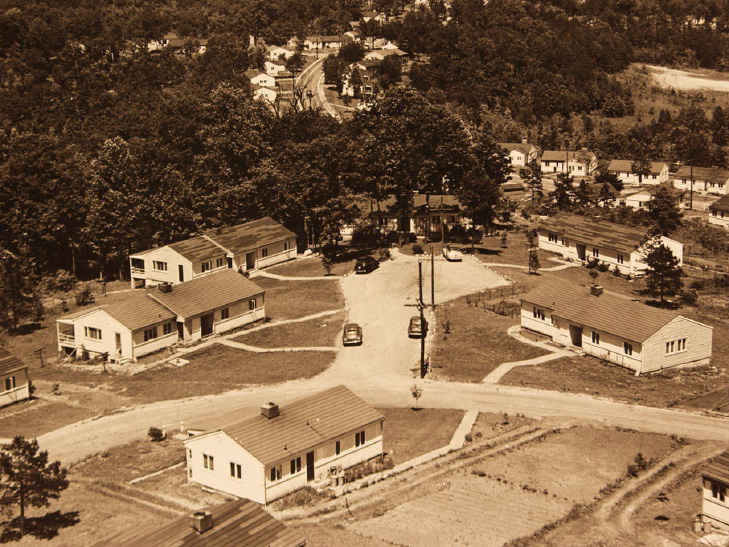In 1942, General Leslie Groves approved Oak Ridge, Tennessee, as the site for the pilot plutonium plant and the uranium enrichment plant. Manhattan Project engineers had to quickly build a town to accommodate 30,000 workers–as well as build the enormously complex plants.
“Site X”
By the time President Roosevelt authorized the Manhattan Project on December 28, 1942, work on the east Tennessee site where the first production facilities were to be built was already underway. On Saturday, September 19, General Leslie Groves Groves had approved the acquisition of 59,000 acres of land along the Clinch River, 20 miles est of Knoxville, Tennessee. Also approved was the removal of relatively few families on the marginal farmland and extensive site preparation to provide the transportation, communications, and utility needs of the town and production plants that would occupy the previously undeveloped area. At first, this location was known as “Site X” and later changed to the Clinton Engineer Works, named after the nearest town. After the war, the name was again changed officially to Oak Ridge.
Designing a Town From Scratch
 Groves appointed 34-year-old Colonel Kenneth D. Nichols as his second in command. Nichols’ title was district engineer for the Manhatttan Engineer District (MED). Using the Andrew Jackson Hotel in Knoxville as his base, Nichols began working on the production site in East Tennessee. First, Nichols had a road built between Knoxville and Oak Ridge. Next, he hired Skidmore, Owings and Merrill (SOM), a New York architectural and engineering firm, to design a town for 30,000 people from scratch. SOM was given some aerial photographs and a few topographical maps but no information about its secret location. Once the Army approved their initial plan, the entire SOM office of 400 people moved to Tennessee. The team produced one of the fastest and most skillful jobs of town planning ever seen.
Groves appointed 34-year-old Colonel Kenneth D. Nichols as his second in command. Nichols’ title was district engineer for the Manhatttan Engineer District (MED). Using the Andrew Jackson Hotel in Knoxville as his base, Nichols began working on the production site in East Tennessee. First, Nichols had a road built between Knoxville and Oak Ridge. Next, he hired Skidmore, Owings and Merrill (SOM), a New York architectural and engineering firm, to design a town for 30,000 people from scratch. SOM was given some aerial photographs and a few topographical maps but no information about its secret location. Once the Army approved their initial plan, the entire SOM office of 400 people moved to Tennessee. The team produced one of the fastest and most skillful jobs of town planning ever seen.
Following the contours of Black Oak Ridge, the town was a narrow strip less than one mile wide and six miles long. SOM designed 3,000 prefabricated houses made from “cemesto,” a cement-asbestos board. The houses were shipped from a factory in Indiana complete with walls, floors, room partitions, interior wiring, plumbing and furniture. The homes were quickly installed along streets that followed the natural contours of the hills. By the end of the war, Oak Ridge was the fifth largest city in Tennessee and was consuming 1/7 of all the electrical power being produced in the United States. While the Army and its contractors tried desperately to keep up with the rapid influx of workers and their families, services always lagged behind demand.
The Plants

The three production facility sites were located in valleys away from the town. This provided security and containment in case of accidental explosions. The Y-12 area, home of the electromagnetic plant, was closest to Oak Ridge. Farther to the south and west lay both the X-10 area, which contained the experimental plutonium pile and separation facilities, and K-25, site of the gaseous diffusion plant and later the S-50 thermal diffusion plant. Y-12 and X-10 were begun earlier in 1943 than was K-25, but all three were well along by the end of the year.
Life in the Secret City
.jpg)
Part of Oak Ridge’s appeal to Manhattan Project planners was nearby Knoxville with its population of 111,000. However, the top-secret project was not warmly welcomed in Knoxville, arousing both suspicion and resentment. Many saw the people flooding into East Tennessee from all over the country—and the world—as “furriners” who could not be questioned. In a time of austerity and rationing, others resented Oak Ridge residents arriving with unlimited ration stamps and fistfuls of cash. Oak Ridgers who ventured into Knoxville were easy to spot. The quickly constructed secret city was blanketed in a thick layer of mud. As a result, its residents’ muddy shoes were a dead giveaway as to their origin.




